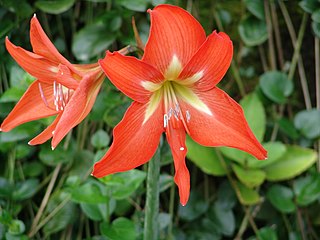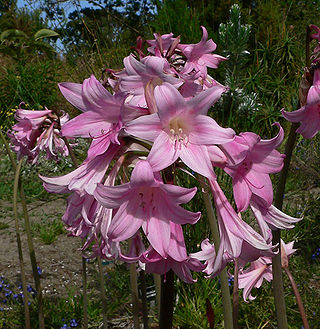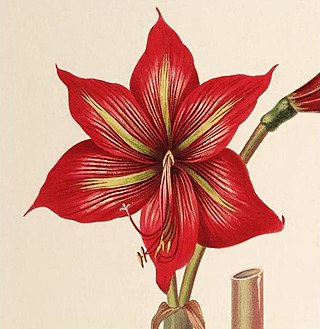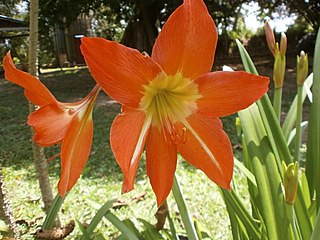
Amaryllis is the only genus in the subtribe Amaryllidinae. It is a small genus of flowering bulbs, with two species. The better known of the two, Amaryllis belladonna, is a native of the Western Cape region of South Africa, particularly the rocky southwest area between the Olifants River Valley and Knysna.

Hippeastrum is a genus of about 90 species and over 600 hybrids and cultivars of perennial herbaceous bulbous plants. They generally have large fleshy bulbs and tall broad leaves, generally evergreen, and large red or purple flowers.

Amaryllis belladonna, the Jersey lily, belladonna-lily, naked-lady-lily, or March lily, is a plant species native to Cape Province in South Africa but widely cultivated as an ornamental. It is reportedly naturalized in many places: Corsica, Portugal, the Azores, Madeira, the Canary Islands, the Scilly Isles of Great Britain, the Democratic Republic of the Congo, Ascension Island, Australia, New Zealand, Mexico, Cuba, Haiti, the Dominican Republic, Chile, California, Texas, Louisiana, Mississippi, and the Juan Fernández Islands.

The Amaryllidaceae are a family of herbaceous, mainly perennial and bulbous flowering plants in the monocot order Asparagales. The family takes its name from the genus Amaryllis and is commonly known as the amaryllis family. The leaves are usually linear, and the flowers are usually bisexual and symmetrical, arranged in umbels on the stem. The petals and sepals are undifferentiated as tepals, which may be fused at the base into a floral tube. Some also display a corona. Allyl sulfide compounds produce the characteristic odour of the onion subfamily (Allioideae).

Hippeastrum aulicum, the Lily of the Palace, is a bulbous perennial, in the family Amaryllidaceae, native to the Atlantic Forest and Cerrado ecoregions from Brazil to Paraguay, in South America.

Hippeastrum correiense is a flowering perennial herbaceous bulbous plant, in the family Amaryllidaceae, native to Brazil.

Hippeastrum cybister is a flowering perennial herbaceous bulbous plant, in the family Amaryllidaceae, native from Bolivia to Argentina.

Hippeastrum ferreyrae is a flowering perennial herbaceous bulbous plant, in the family Amaryllidaceae, native to Peru.
Lois Brako is an American botanist, mycologist and explorer. She has conducted botanical expeditions in Peru.
Hippeastrum leopoldii is a flowering perennial herbaceous bulbous plant, in the family Amaryllidaceae, distributed from Peru to Bolivia.

Hippeastrum miniatum is a flowering perennial herbaceous bulbous plant, in the family Amaryllidaceae, native to Peru.

Hippeastrum papilio is a flowering perennial herbaceous bulbous plant, in the family Amaryllidaceae, native to southern Brasil.

Omphalissa is an unaccepted subgenus of genus Hippeastrum, within the family Amaryllidaceae. Originally described by Richard Anthony Salisbury in 1866.

Phycella is a genus of herbaceous, perennial bulbous flowering plants belonging to the family Amaryllidaceae, subfamily Amaryllidoideae. The genus consists of five species distributed from central Chile to northwestern Argentina.
Hippeastrum petiolatum is a flowering perennial herbaceous bulbous plant, in the family Amaryllidaceae, distributed from Paraguay to Uruguay and Argentina.

Hippeastrum psittacinum is a flowering perennial herbaceous bulbous plant, in the family Amaryllidaceae, native to Brazil.

Hippeastrum reginae is a flowering perennial herbaceous bulbous plant, in the family Amaryllidaceae, native to Venezuela, Bolivia, Peru and Brazil.

Hippeastrum striatum, the striped Barbados lily, a flowering perennial herbaceous bulbous plant, in the family Amaryllidaceae, native to the southern and eastern regions of Brazil.

Hippeastrum mirum is a species of herbaceous perennial bulbous flowering plants in the amaryllis family, Amaryllidaceae, subfamily Amaryllidoideae. It was formerly treated as Tocantinia mira, the only species in the monotypic genus Tocantinia.

Hippeastrum reticulatum, the netted-veined amaryllis, is a flowering perennial herbaceous bulbous plant, in the family Amaryllidaceae, native to South America.



















